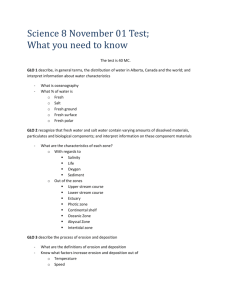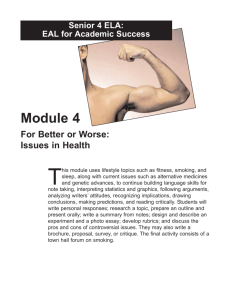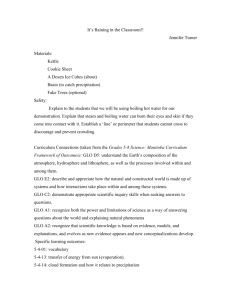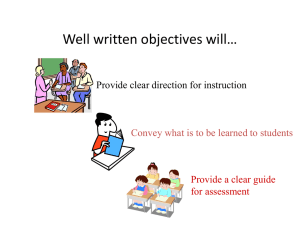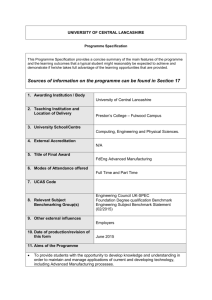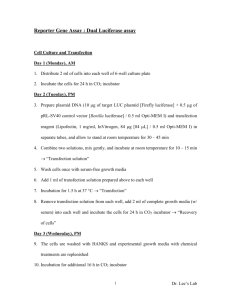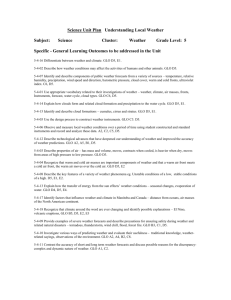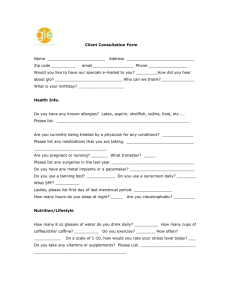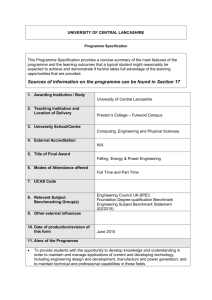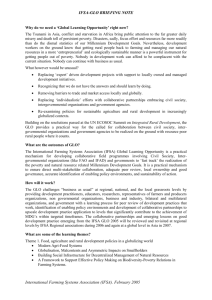Principles in HVAC I - Southern State Community College
advertisement
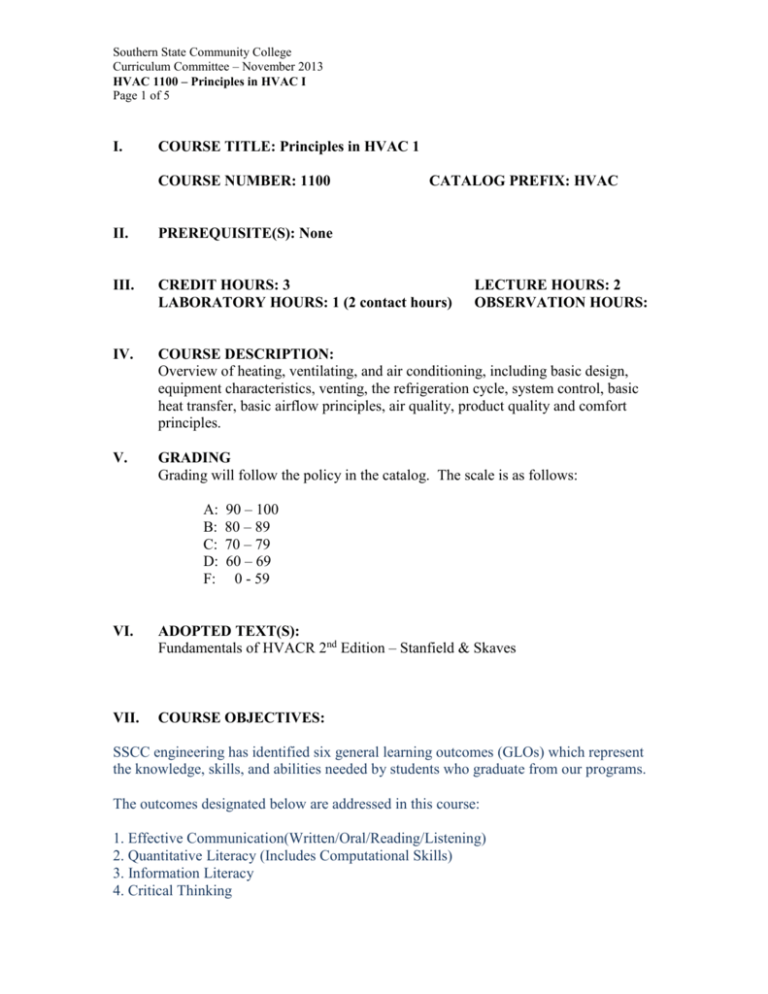
Southern State Community College Curriculum Committee – November 2013 HVAC 1100 – Principles in HVAC I Page 1 of 5 I. COURSE TITLE: Principles in HVAC 1 COURSE NUMBER: 1100 CATALOG PREFIX: HVAC II. PREREQUISITE(S): None III. CREDIT HOURS: 3 LABORATORY HOURS: 1 (2 contact hours) IV. COURSE DESCRIPTION: Overview of heating, ventilating, and air conditioning, including basic design, equipment characteristics, venting, the refrigeration cycle, system control, basic heat transfer, basic airflow principles, air quality, product quality and comfort principles. V. GRADING Grading will follow the policy in the catalog. The scale is as follows: A: B: C: D: F: LECTURE HOURS: 2 OBSERVATION HOURS: 90 – 100 80 – 89 70 – 79 60 – 69 0 - 59 VI. ADOPTED TEXT(S): Fundamentals of HVACR 2nd Edition – Stanfield & Skaves VII. COURSE OBJECTIVES: SSCC engineering has identified six general learning outcomes (GLOs) which represent the knowledge, skills, and abilities needed by students who graduate from our programs. The outcomes designated below are addressed in this course: 1. Effective Communication(Written/Oral/Reading/Listening) 2. Quantitative Literacy (Includes Computational Skills) 3. Information Literacy 4. Critical Thinking Southern State Community College Curriculum Committee – November 2013 HVAC 1100 – Principles in HVAC I Page 2 of 5 5. Global and Diversity Awareness 6. Civic, Professional, and Ethical Responsibility Upon successful completion of this course, students should be able to: 1. 2. 3. 4. 5. 6. 7. 8. 9. 10. 11. 12. 13. 14. 15. 16. 17. 18. 19. 20. 21. 22. 23. 24. 25. 26. 27. 28. 29. 30. 31. 32. 33. Give a brief history of HVACR (GLO 1, 3). Define environmental heating & air conditioning (GLO 1, 3). Describe how to develop good communication with the customer (GLO 1, 3). Discuss electrical safety rules (GLO 1, 3). Discuss the safe use of refrigerants, their storage, & proper disposal (GLO 1, 3, 6) Describe how the major HVACR tools are used (GLO 1, 3). Name the physical & thermal properties of matter, & tell why it is important for the HVACR worker to understand them (GLO 1, 3). Diagram the electrical distribution system (GLO 1, 2, 3). Define temperature & explain the effect it has on a substance (GLO 1, 3). Demonstrate how to convert temperature from one scale to another (GLO 1, 2, 3). Compare & contrast the three basic methods of heat transfer (GLO 1, 2, 3) Explain the factors that affect the rate that heat transfers through various materials (GLO 1, 3). Explain the relationship between atmospheric pressure, gauge pressure, & absolute pressure (GLO 1, 3) Describe how gas responds to changes in temperature, volume, & pressure (GLO 1, 2, 3). Define refrigeration (GLO 1, 3).` Explain the fundamental principles behind the compression-refrigeration cycle (GLO 1, 3). Discuss the difference between the compression cycle and the absorption cycle (GLO 1, 3). Explain the fundamental principles behind the refrigeration cycle (GLO 1, 3). Identify the four major components of the compression cycle (GLO 1, 3). Draw a basic compression-refrigeration cycle & identify the pressure, temperature, state, & heat content in & out of each component (GLO 1, 3). Describe the harmful effects of electrical accidents (GLO 1, 3, 6). Recognize the significance of proper electrical safety procedures (GLO 1, 3, 6). Explain the function of ground fault circuit interrupters (GFCI) (GLO 1, 3). Lockout & tag out an electrical circuit (GLO 1, 3, 6). Test a circuit for voltage to make sure it is de-energized (GLO 1, 3). Explain the safety importance of fuse & breaker amperage capacities (GLO 1, 3, 6). Describe why electrical wire types and sizes are important to safety (GLO 1, 3, 6). Discuss the factors affecting human comfort (GLO 1, 3, 6). Explain the relationship between dry-bulb, wet-bulb, and dew-point temperatures (GLO 1, 3). Calculate CFM from velocity & area (GLO 1, 2, 3). List the types of air filters (GLO 1, 3). List the types of air contaminants (GLO 1, 3). Explain the MERV efficiency rating system (GLO 1, 3). Southern State Community College Curriculum Committee – November 2013 HVAC 1100 – Principles in HVAC I Page 3 of 5 34. Explain how an electronic air cleaner works (GLO 1, 3). 35. Discuss the importance of pressure drop & airflow rating when selecting an air filter (GLO 1, 3, 4, 6). 36. List the most common types of fuel gasses and compare their properties (GLO 1, 3). 37. List the three essential components of complete combustion (GLO 1, 3). 38. List the products of complete combustion (GLO 1, 3). 39. Define the meaning of indoor air quality (IAQ) (GLO 1, 3). 40. State the HVACR technician’s role as it relates to indoor air quality (GLO 1, 3, 4, 6). 41. Identify various pollutants and pollutant pathways that affect indoor air quality (GLO 1, 3). 42. List several tools & instruments to help measure & evaluate indoor air quality (GLO 1, 3). 43. Explain appropriate strategies to prevent, control, & resolve certain issues related to indoor air quality (GLO 1, 3). 44. Set limits that guide when other professional need to be involved in addressing indoor air quality issues (GLO 1, 3, 4, 6). VIII. COURSE METHODOLOGY: Classroom lecture and Lab. Suggested method of assessment below, see also XI. Method of Assessment Quizzes (GLO 1, 2, 3, 4, 6) Exams (GLO 1, 2, 3, 4, 6) Lab Reports (GLO 1, 2, 3, 4, 6) Comprehensive Final Exam (GLO 1, 2, 3, 4, 6) Professionalism (GLO 6) IX. Percentage Value of Total Grade 15% 40% 20% 15% 10% COURSE OUTLINE: Week 1 Units 1 & 2 Introduction to HVAC/R; Being a Professional HVAC/R Technician 2 Units 3 & 4 Safety; Hand and Power Tools 3 Unit 5 Fasteners 4 Exam 1 (Units 1-5); Unit 6 Measurements 5 Unit 7 Properties of Matter 6 Unit 8 Types of Energy and Their Properties 7 Types of Energy and Their Properties continued Southern State Community College Curriculum Committee – November 2013 HVAC 1100 – Principles in HVAC I Page 4 of 5 8 9 10 11 12 13 14 15 16 Unit 9 Temperature Measurement and Conversion Unit 10 Thermodynamics – The Study of Heat Exam 2 (Units 6-10); Unit 11 Pressure and Vacuum Unit 13 Types of Refrigeration Systems Unit 14 Vapor Compression Refrigeration Cycle Unit 32 Electrical Safety Exam 3 (Units 11, 13, 14 &32); Unit 41 Psychrometrics and Airflow Unit 42 Filters, Unit 48 Principles of Combustion and Safety Unit 69 Indoor Air Quality; Exam 4 (Units 41, 42, 48, 69) Comprehensive Exam X. OTHER REQUIRED TEXTS, SOFTWARE, AND MATERIALS: None XI. EVALUATION: Assignments will be evaluated according to instructor directives. Typically: The grade will be determined by periodic examinations, observation, a comprehensive final examination, homework, class participation, and the laboratory assignments and reports. It is suggested: Class Participation = 5% Assignments = 25% Examinations (4) = 40% Final Examination = 30% XII. SPECIFIC MANAGEMENT REQUIREMENTS: Students will be required to complete written exams at times designated in the Course Schedule. Students are required to participate in all class activities. XIII. OTHER INFORMATION: FERPA: Students need to understand that your work may be seen by others. Others may see your work when being distributed, during group project work, or if it is chosen for demonstration purposes. Students also need to know that there is Southern State Community College Curriculum Committee – November 2013 HVAC 1100 – Principles in HVAC I Page 5 of 5 a strong possibility that your work may be submitted to other entities for the purpose of plagiarism checks. DISABILITIES: Students with disabilities may contact the Disabilities Service Office, Central Campus, at 800-628-7722 or 937-393-3431.
